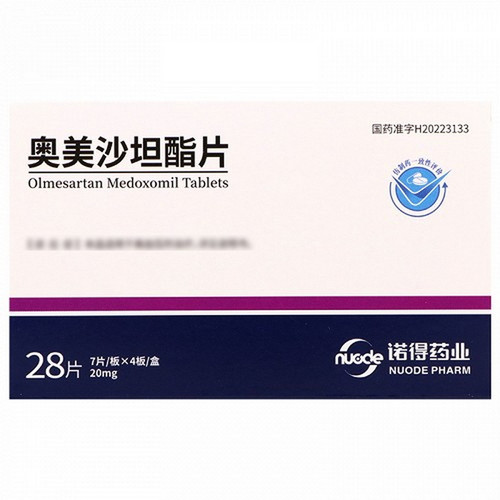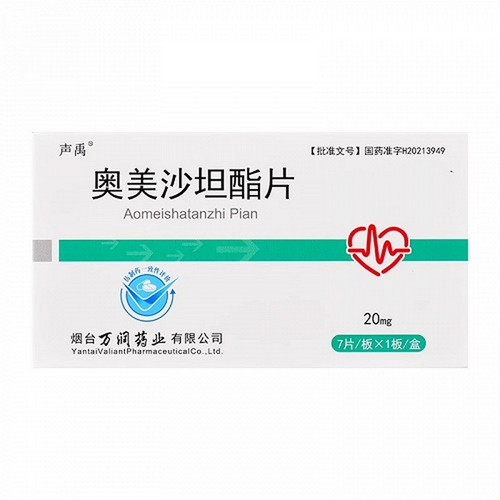Product Overview
[Drug Name]
Generic Name: Olmesartan Medoxomil Tablets
Trade Name: Dongyangguang Olmesartan Medoxomil Tablets 20mg*28 Tablets
Pinyin Code: DongYangGuang AoMeiShaTanZuoPian 20mg*28 Tablets
[Main Ingredient]
Olmesartan Medoxomil
[Properties]
This product is a white film-coated tablet that appears white after removal of the coating.
[Indications/Main Functions]
Indicated for the treatment of hypertension.
[Specifications]
20mg*28 tablets
[Dosage and Administration]
Dosage should be individualized. For normovolemic patients, as monotherapy, the recommended starting dose is 20mg once daily. For patients who require further blood pressure lowering after two weeks of treatment, the dose can be increased to 40mg. Doses greater than 40mg have not demonstrated a greater antihypertensive effect. When the daily dose is the same, twice-daily dosing has not demonstrated superiority compared to once-daily dosing. This product can be taken with or without food. This drug can be used in combination with other diuretics or other antihypertensive medications. No dose adjustment is required for elderly patients and patients with moderate to significant hepatic or renal impairment (creatinine clearance 40 mL/minute). Olmesartan medoxomil should be used under close medical supervision in patients with potential volume depletion (e.g., those receiving diuretic therapy, particularly those with renal impairment), and a lower starting dose may be considered.
[Adverse Reactions]
The safety of olmesartan medoxomil was evaluated in controlled clinical trials involving up to 3275 patients, of whom approximately 900 received treatment for at least 6 months and more than 525 received treatment for at least 1 year. Results showed that olmesartan medoxomil was well tolerated, with an adverse event rate similar to that in the placebo group. Adverse events were generally mild and transient, and were not related to dose, gender, age, or race. In placebo-controlled clinical trials, the only adverse event reported at a greater than 1% incidence in olmesartan medoxomil-treated patients and at a higher incidence than in the placebo group was dizziness (3% vs. 1%). Adverse events with an incidence greater than 1% similar to that in the placebo group included back pain, bronchitis, increased creatine phosphokinase, diarrhea, headache, hematuria, hyperglycemia, hypertriglyceridemia, flu-like symptoms, pharyngitis, rhinitis, and sinusitis. The incidence of cough was similar in the placebo group (0.7%) and the olmesartan medoxomil group (0.9%). Adverse events with an incidence less than 1% but greater than 0.5% similar to that in the placebo group included chest pain, fatigue, pain, peripheral edema, dizziness, abdominal pain, dyspepsia, gastroenteritis, nausea, tachycardia, hypercholesterolemia, hyperlipidemia, hyperuricemia, arthralgia, arthritis, myalgia, bone pain, rash, and facial edema. Whether these adverse events are related to the use of this product is unknown. Laboratory test results: In controlled clinical trials, changes in clinically important laboratory parameters were rarely associated with olmesartan medoxomil. Hemoglobin and Hematocrit: Slight decreases in hemoglobin and hematocrit may occasionally occur (average decreases of approximately 0.3 g/dL and 0.3 volume percent, respectively). Liver Function Tests: Elevated liver enzymes and/or elevated blood bilirubin may occasionally occur, but these levels will return to normal spontaneously. Past Market Experience: There have been rare reports of rhabdomyolysis associated with angiotensin II receptor antagonists.
[Contraindications]
European and American steroid tablets should not be used in patients with hypersensitivity to the ingredients contained in them.
[Precautions]
1. Renal Artery Stenosis: There have been reports that ACE inhibitors may increase serum creatinine or blood urea nitrogen (BUN) in patients with unilateral or bilateral renal artery stenosis. However, there is no experience with long-term use of this product in such patients, but similar results may be expected. 2. Renal Impairment: In patients whose renal function depends on the activity of the renin-angiotensin-aldosterone system (such as those with severe congestive heart failure), the use of ACE inhibitors and AT1 receptor antagonists may result in oliguria and/or progressive azotemia, acute renal failure, and/or death (rarely). Similar outcomes are expected with olmesartan therapy in such patients. 3. Fetal/Neonatal Morbidity and Mortality: In pregnancy category D (pregnancy I and II), drugs that directly act on the renin-angiotensin system (RAS) have been associated with fetal and neonatal harm, including hypotension, neonatal craniosynostosis, anuria, reversible or irreversible renal failure, and death. Oligohydramnios, preterm birth, intrauterine growth retardation, and patent ductus arteriosus have also been reported, although it is unclear whether these are related to the drug use. Olmesartan medoxomil tablets should be discontinued as soon as pregnancy is discovered. If medication is necessary, pregnant women should be informed of the potential risk to the fetus and undergo serial ultrasound examinations to assess the amniotic fluid. Infants who have been exposed to angiotensin I receptor antagonists in utero should be closely monitored for hypotension, oliguria, and hyperkalemia, and appropriate treatment should be administered if necessary. 4. Hypotension in Patients with Volume Depletion or Hyponatremia: Patients with volume depletion or hyponatremia (e.g., those receiving high-dose diuretics) may experience symptomatic hypotension after the first dose of this drug and must be treated with this drug under close medical supervision. If hypotension occurs, the patient should be placed supine and, if necessary, receive intravenous saline. Once blood pressure stabilizes, treatment with this drug can be continued. Patients with Hepatic or Renal Impairment: No dose adjustment is required for patients with moderate to significant renal impairment (creatinine clearance <40 mL/minute) or moderate to significant hepatic impairment (see Special Populations in Pharmacokinetics).







